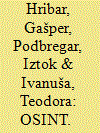|
|
|
Sort Order |
|
|
|
Items / Page
|
|
|
|
|
|
|
| Srl | Item |
| 1 |
ID:
139510


|
|
|
|
|
| Summary/Abstract |
Our intention is to demonstrate, based on research, which elements support teamwork in HUMINT, or alternatively to show the advantage of using traditional intelligence methods. We conducted research among the operational intelligence officers of the intelligence services of Bosnia and Herzegovina, Montenegro, and Slovenia. These intelligence services, which evolved in the 1990s, witnessed the disintegration of the Socialist Federal Republic of Yugoslavia (SFRY) in 1992 and the establishment of new countries in the Balkan region, along with experiencing the area's cruelest wars. The Republic of Slovenia, the first to gain independence from the SFRY, was also the first to become a member of the European Union (EU) and North Atlantic Treaty Organization (NATO). Bosnia and Herzegovina underwent a terrifying war. The Dayton Agreements set the elements for the establishment of the new country's intelligence community but today “Dayton” clearly needs an appropriate update. Montenegro, a country with a long tradition, was not directly entangled in the Balkan wars of the ‘90s. Due to its geo-strategic position, however, its territory and inhabitants were often a logistics base or a refuge for various paramilitary groups and individual war criminals, whether in the direction of western Bosnia and Herzegovina or towards northeast Kosovo.
|
|
|
|
|
|
|
|
|
|
|
|
|
|
|
|
| 2 |
ID:
132431


|
|
|
|
|
| Publication |
2014.
|
| Summary/Abstract |
Open Source Intelligence (OSINT) is generally seen in positive terms, particularly as a method of conventional intelligence collection that does not violate human rights. Of all the data collection methods, OSINT is, arguably, the only fully legal method. It can be conducted anytime, anywhere, and with any (legal) tools/software, as long as it does not violate human rights. In principle, however, OSINT does not and should not violate human rights, therefore such tools are all, again arguably, legal. Thus, its legality makes OSINT globally available, including to markets around the world. The free market offers various legal tools that facilitate the analytical procedures of data acquisition and analysis, and which no longer represent a major technical and logistical obstacle. Hypothetically, OSINT can be carried out by anyone with such specific tools and knowledge. These tools can be obtained by anyone free of charge or by paying for the licensed program, while the knowledge necessary to conduct OSINT is relatively easily acquired. Even though the tools and knowledge are freely accessible, the major difference between basic and excellent OSINT "operations" lies in the analytical process. Only experts with good analytical skills and knowledge manage to provide the right information at the right time to their customers/policymakers. OSINT is also a formal tool and means of analytical support in the work of intelligence services. Intelligence service analysts are capable of the advanced use of OSINT-they are familiar with specialized sources of specific data, advanced techniques of acquiring data, and the analytical steps needed for successful processing, exploitation, and analysis of massive amounts of data. The exploitation of special sources and the use of advanced techniques make OSINT questionable when seen through the prism of legality. The exploitation is at times semi-legal or even, arguably, illegal. The use of "special" techniques in OSINT can therefore lie on the edge between the legal and the illegal. These actions are sometimes clearly illegal, of course, and therefore forbidden by the criminal law; such practice by the intelligence services is not sanctioned. This raises the following questions: Could the intelligence services using OSINT in a legal manner to serve their specific individual interests interfere in another country on the ground of this same legality? Without this hypothetical "grey zone" would they be acting illegally and so become subject to counterintelligence observation?
|
|
|
|
|
|
|
|
|
|
|
|
|
|
|
|
| 3 |
ID:
119422


|
|
|
|
|
| Publication |
2013.
|
| Summary/Abstract |
Over the past twenty years, the Republic of Slovenia has followed the path of intensive democratic development. Becoming an independent state after being one of the Republics of the Former Socialist Federal Republic of Yugoslavia, the country's leadership set important strategic objectives, especially full membership in the European Union and the North Atlantic Treaty Organization (NATO), and achieved quality results in the economic field. Slovenia's development model is still being followed by Western Balkan countries in the aftermath of the brutal wars in this region. Thus, its activities and democratic development are extremely important for the development, stability, and security of the Western Balkan region.
|
|
|
|
|
|
|
|
|
|
|
|
|
|
|
|
|
|
|
|
|